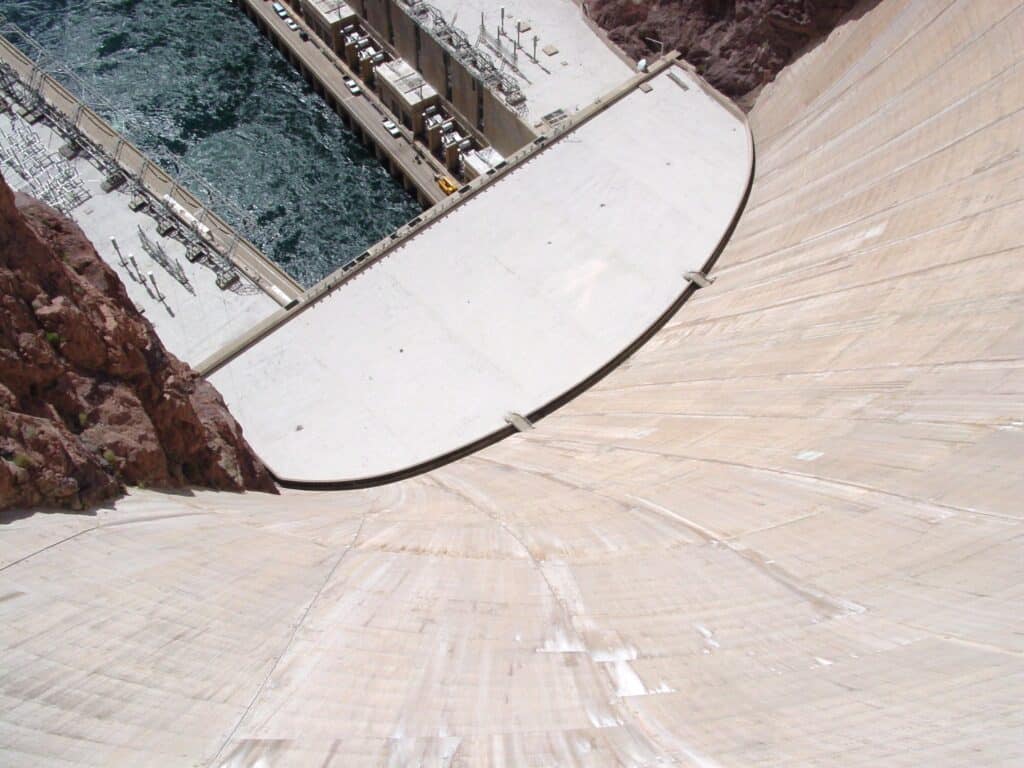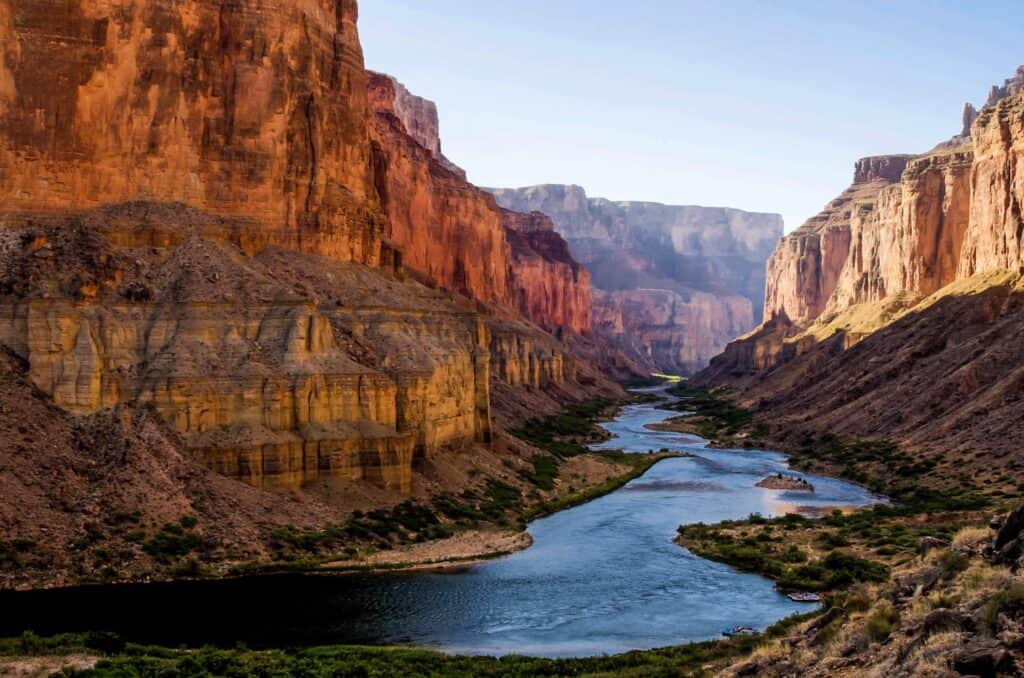The Hoover Dam is one of the iconic American monuments and has been designated as a National Historic Landmark. It is also listed on the National Register of Historic Places. Construction on the iconic dam began in 1931, officially concluding four years later.
This dam has served millions of Americans over the past several decades. It keeps Arizona and California safe from floods while ensuring power and water supply to emerging cities in the southwest and metropolitan areas like Los Angeles. The dam sees thousands, if not millions, of visitors each year, putting visitors in awe with its sheer size.
How Big Is the Hoover Dam?
The Hoover Dam is 726 feet high from its base to the top and is 1,244 feet long at the top. It is 660 feet thick at the bottom, gradually thinning into 45 feet at the very top. At the time of its construction, the dam’s reservoir was the largest artificial lake in the world, and it continues to be the largest in the U.S.
It is almost as tall as a 60-story complex, while the thickness of the Hoover Dam’s base is equivalent to the length of two football fields. The water flow within the spillways is comparable to the enormous Niagara Falls.
To put things in perspective, the amount of concrete utilized during the dam’s construction would be sufficient to lay out a road stretching from San Francisco, CA, to New York City.

The Hoover Dam is 726 feet high from its base to the top.
©kevin/Shutterstock.com
Where Is the Hoover Dam Situated?
Classifying the Hoover Dam as “big” is an understatement. It is situated in an area where the Colorado River serves as a natural border for Nevada and Arizona. Prior to the construction of the Hoover Dam, the Colorado River was considered unstable and even dangerous. But the problems didn’t completely disappear after the completion of the dam.
Why Was the Hoover Dam Built?
There were multiple reasons behind the construction of the Hoover Dam. While the common belief is that the dam was built to generate hydroelectric power, it also served other purposes. For one, more people started heading west to settle down with their families.
This meant that water consumption increased significantly, as did demand. So, the dam effectively helped divert water to regions where the rivers didn’t flow. As we’ve already touched on above, the Colorado River flooded frequently. Therefore, the construction of a dam effectively helped the people keep a check on the unstable waters.
With construction formally beginning in 1931, public interest in this monumental project was piquing. Many made the journey from distant lands, going through a desert, just to catch a glimpse of this engineering marvel. Builders at the site later set up an observation platform on the canyon’s rim to ensure tourists could take in the sights from a distance.
Engineers and builders utilized 3.25 million cubic yards of concrete to construct the dam. Meanwhile, they used a total of 1.11 million cubic yards of the material for the power plant and other buildings adjoining the dam.

One reason for the Hoover Dam’s construction was to prevent flooding from the Colorado River from affecting Arizona and California.
©Beth Ruggiero-York/Shutterstock.com
Why Is It named Hoover Dam?
The location of Hoover Dam was advised to come up in Boulder Canyon. But even after surveyors later decided that Black Canyon was a more suitable site, the name Boulder stuck with the dam. Speaking in September 1930 at a ceremony to mark the building of a railroad line connecting the dam, Secretary of the Interior Ray L. Wilbur formally announced that the dam would be rechristened as the “Hoover Dam” after President Herbert Hoover.
Following Franklin D. Roosevelt’s succession to the White House in 1933, incoming Secretary of the Interior, Harold Ickes, mentioned that the dam would be known as Boulder Dam. The political climate of the time was aggressively against President Hoover, blaming his administration for a number of issues, including but not limited to the Great Depression.
Finally, in April 1947, President Harry Truman okayed a resolution from Congress to rename the dam after Hoover. It’s impossible to think today that Hoover Dam was known by another name, but in the years after its construction, it was known as both Boulder Dam and Hoover Dam, depending on the person’s political leanings.
Problems Along the Way
A few years after its construction, the area surrounding Hoover Dam witnessed more than 600 small earthquakes. Scientists say this is due to the sheer volume of water stored within the dam, which, in turn, had disturbed the earth’s crust.
Furthermore, builders and engineers of the Bureau of Reclamation faced a multitude of challenges along the way. Records show that 96 of the 21,000 men who worked on this colossal structure lost their lives during construction. Moreover, 42 workers died from illnesses between the beginning and the conclusion of the project.
When the construction first began in April 1931, Southern Nevada was facing unprecedented heat waves. Temperatures reached as high as 119 degrees Fahrenheit in June of the same year. The tunnels used during the construction of the dam weren’t in great shape either. Builders working in the depths of the tunnels could face temperatures of up to 130 to 140 degrees Fahrenheit. This meant that occurrences of heat stroke were pretty common during the course of Hoover Dam’s construction.
Is Hoover Dam the Largest in the US?
At the time of construction, Hoover Dam was the tallest in the U.S. But not more than a couple of decades later, California’s Oroville Dam took the throne from Hoover Dam, with a height of 770 feet. No other dam built in the future has come close to the height of the Oroville Dam. It experienced a dangerous spillway failure in 2017, which led to the evacuations of 188,000 people. Thankfully, they fixed the issues later, and the dam has been functioning properly since then.
Although the Hoover Dam is now the second-highest dam in the U.S., it leads the pack in terms of water capacity. It can hold an astonishing 8.95 cubic miles of water, putting it on top of the list among all dams in the U.S. One of its reservoirs, Lake Mead, is crucial for the surrounding ecosystem and also happens to be the largest in the country by water capacity. Today, authorities are keeping a close eye on Lake Mead, as any dip in its capacity could put the dam’s functioning at risk.
Which Are the Highest Dams in the US?
Oroville Dam: Completed in 1969, this dam took over the mantle of the highest dam in the United States from the Hoover Dam. The Oroville Dam measures 770 feet in height.
Hoover Dam: At 726 feet, the Hoover Dam is a gargantuan monument, particularly considering the time of its construction. The project passed through multiple administrations. Its completion was two years ahead of schedule.
Dworshak Dam: The 717-foot Dworshak Dam is situated on the North Fork Clearwater River in Idaho. Its key purposes are flood control and hydroelectricity generation. Construction on this dam began in 1966 and finished in 1973.
Glen Canyon Dam: Not much smaller than the Dworshak Dam, the Glen Canyon Dam is a concrete arch-gravity dam measuring 710 feet. It stands in northern Arizona on the Colorado River.
New Bullards Bar Dam: The fifth tallest dam in the U.S., the 645-foot dam became operational in 1969. This is a radius concrete arch dam, located southeast of the country’s tallest dam, Oroville.
Unknown Facts about Hoover Dam
Plot to destroy the dam during WWII
Not many people probably know this today, but the Nazis planned to bomb the Hoover Dam. U.S. security officials learned of the threat in November 1939 and were able to quell the threat. As a consequence, officials limited the entry of dam employees and boats into Black Canyon.
The destruction of the Hoover Dam would have led to a severe crisis in the country’s economy, as it would effectively cut electricity to southern California. The region was of crucial strategic importance to the United States, given the airplane production industry was set up there.
Hoover Dam was shut down for all visitors after the December 1941 attack on Pearl Harbor. This attack also marked the United States’ entry into WWII. The dam reopened after the war concluded in 1945.
Engineers used a faster concrete cooling process in its construction
It’s conventional wisdom that concrete takes a while to dry. Considering the volume of concrete engineers used during the Hoover Dam’s construction, cooling it quickly was a massive challenge. By some estimates, sticking to pre-existing methods of concrete cooling in the 1930s would have taken approximately 125 years for it to cool completely.
To hasten the process, engineers devised a refrigeration system that could produce more than 1,000 tons of ice per day. After pouring concrete blocks, engineers would place multiple one-inch pipes inside them, which would then send down ice water. Thanks to this process, each large block of concrete would only require two months to cool completely. A positive side effect of this method was that concrete was less prone to cracks.
An entire city emerged thanks to Hoover Dam
Situated in Clark County, Nevada, Boulder City is a small town with a population of just over 16,000 as of the year 2020. This city didn’t exist before the Hoover Dam project. One of Boulder City’s primary purposes was to shelter the 5,000 builders and other workers involved in the construction of the dam. Records show that the whole city was under the management of a single employee of the U.S. Bureau of Reclamation. This continued until 1960, when the federal government finally let go of the region, thus helping Boulder City’s incorporation.
Next Up…
- Discover the 10 Largest Dams In The United States: Interested in learning more about various dams in the United States? Find out here.
- Discover the 10 Tallest Dams on Earth: It takes a lot to build something that would stop the force of nature like a river. Here are some of the tallest dams in the world.
- How Much Power Does The Hoover Dam Generate?: Hoover dam is one of the most significant dams in the USA. How much power does it generate? Find out here.
The photo featured at the top of this post is © Matej Hudovernik/Shutterstock.com
Thank you for reading! Have some feedback for us? Contact the AZ Animals editorial team.






